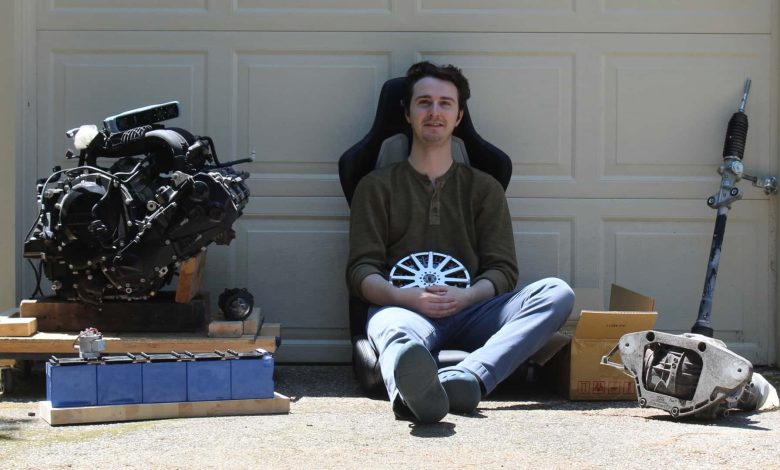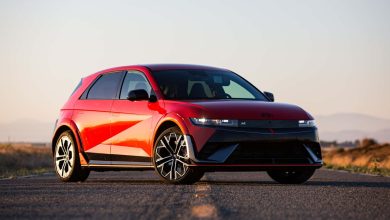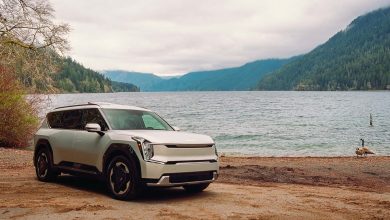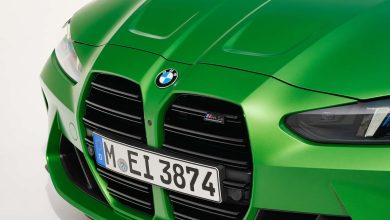Let’s Build a Car

Eight years ago, I began a college degree in industrial design. I did it because I loved cars. It didn’t work out how I thought. About halfway through my degree, I realized that I didn’t want to design just the interior or exterior of a vehicle; I wanted to design the whole thing. As it turns out, that’s a gig that doesn’t really exist.
I finished my degree, pivoted my career out of design, and now I work as a journalist, writing about machines that extremely talented people have toiled over for years.
And there is a massive car-shaped hole in my life. Let’s change that.
The Concept
I am going to build a car.
This project will be a little different than other custom cars because I will not be starting with an existing vehicle or fabricating almost any of the parts. Rapid prototyping technology has come very far in a very short time. Making an entire vehicle with almost zero hard tooling is possible. At least a lightweight hybrid sports car. If that sounds unreasonable, well, let me talk you into it.
Assuming it works, this vehicle will effectively be an open-source kit car, theoretically buildable by almost anyone with a garage and the right tools. Every single part will have a precise specification and a supplier. Let’s talk about the actual specs, though.
The bones of this vehicle, like its chassis and suspension, will be custom. The engine, transmission, electric motor, and differentials are not. There are a handful of great engine candidates out there, but one in particular became the favorite: The 1.6-liter straight-six out of a BMW K1600 motorcycle. Many have theorized about putting this engine in a car and I know a few who have actually done it.
The BMW straight-six is a great engine. It makes 160 horsepower via natural aspiration, has a six-speed sequential transmission, and revs out to 8,500 RPM. There are other good things about it too, but the sound and the power are the big ones. Think of it as half of the almighty BMW S54, which powered the E46 M3 from 2001-2006.
The 1.6-liter inline-six out of a BMW K1600 motorcycle
Because I chose this engine, getting the car working will be considerably harder. The most well-rounded candidate would’ve been a flat-four out of a Honda Goldwing. There are several advantages to using a Goldwing engine—especially an older carbureted one—over the six-cylinder in the K1600. However, I wanted to be sure that the internal-combustion drivetrain would be excellent regardless of the electric side of things. Many sporty hybrid cars get that wrong and I will not make that mistake.
A K1600 engine—purchased from eBay with around 20,000 miles on it—is now sitting in my garage. But there’s a big problem: It spins in the wrong direction compared to a car engine. Without addressing this problem, I would have six reverse gears and effectively no way to go forward. This is simultaneously a huge issue but also a pretty silly one.
There are several solutions, but I’ll simply be flipping my rear differential over to make it run backward, i.e. twisting it about the input shaft to put one output flange where the other used to be. A lot of people online say this is a bad idea. That’s almost the whole truth. I have spoken to people who have done it for other projects involving motorcycle engines and, as long as you use a strong differential, it should be fine for this sort of thing. I also spoke to an engineer at General Motors who has spent most of his career just designing gears—a very happy coincidence—and he said it’s ok to do as long as everything stays well-lubricated.
This engine will run on a standalone ECU, which I have never tuned with before. I have spoken to experts in the matter—aka the very helpful people from whom I plan to purchase the system—and they say it’s definitely possible. Stuff like the cam sensors, fuel injectors, and the crank trigger wheel all seem relatively conventional.
Let’s talk about the other half of this formula, though: the electric power.
Electrification
You’ve probably heard of the E-Ray Corvette by now, and my kart is conceptually very similar. My front axle will be powered by an electric motor, a 35.0-kilowatt-capable unit that’s normally used in electric paramotor aircraft. It’s made by a company called Free RC Hobby, which is sponsoring this project. They offer several other more powerful motors that I could’ve used—and even controllers—but this one is lightweight and has the right characteristics to be hooked up to an automotive differential.

The 35-kilowatt motor, designed and built by Free RC Hobby, is typically used in electric paramotor aircraft. Its specifications make it ideal for lightweight cars as well
The front diff is out of an Audi A4. It provides a reduction gear and gets the power to the front wheels. I considered using two motors on the front axle—there are advantages to doing this—but a single motor is the best option for this application. I’ll cover this in a future installment, but in the meantime, if you see me at a bar, it’s best not to mention this stuff. I’ll talk for days.
Juice comes from a 72-volt nominal, 1.4-kilowatt-hour battery pack consisting of 30 prismatic lithium titanate cells in a 30S 1P configuration. It’s the big blue rectangle in the lead image. Made by Toshiba, Mazda uses the same cells in some of their vehicles’ mild hybrid systems.

Mazda uses these Toshiba LTO cells, also known as SCiBs, in some of their vehicle’s mild hybrid systems. They’re ideal for my purposes due to their high power density and stability
I’ve partially assembled this pack and it’s a very impressive unit on paper. It can push around 40 kW (53 horsepower) in a long burst, and charge quickly. Because of the relatively low voltage, the electric power will peter out around 50 miles per hour. With some modification—changing the motor or differential—this speed can be pushed higher at the cost of low-end performance. I’m happy with where the motor sits now, though. High speeds are not my priority as a matter of personal preference and safety.
Like the E-Ray, the pack sits in the vehicle’s structural center tunnel, which is a six-inch square aluminum tube. A ducted high-CFM radiator fan will allow for powerful air cooling through the tunnel and around the pack, but there’s space to add liquid cooling in the future if necessary.

The 1.4-kilowatt-hour pack sits at the front of the center tunnel, near the rest of the electric drivetrain
The great part about these LTO cells is they have a much lower internal resistance as compared to NMC lithium-ion cells, so they don’t get so hot under high current draws. They are also extremely safe—you can hammer a nail into them without much happening—and they can be cycled up to 20,000 times before significant degradation occurs. They’re a great hybrid battery candidate for these reasons and more, with the big caveat being energy density. I don’t need very much energy, though.
The key piece of this puzzle is the inverter to drive the motor. When you go to higher voltages, that becomes a more complex problem. I am avoiding this by nature of the vehicle, though, which I’ll expand on.
As of late, there are good candidates from Flipsky and Trampa that operate under 100V. They are all VESC-based which means the software is the same as what I have been using in the Motocompacto Type R and the quad-motor kart. I plan to have the inverter cooled by a large heatsink that resembles a shaker hood. I think that’s a cool way to show off the electric power. If this doesn’t work, I’ll cave and add radiators.
The Hybrid Magic
72V may sound like too little, even for a hybrid. That’s not the case. There are many excellent reasons to mate a relatively low-voltage hybrid system with a motorcycle engine in a car. The big one is that most motorcycles don’t have a reverse gear, and when people put bike engines in cars, they typically have to buy an expensive gearbox to compensate or improvise some kind of other solution. My electric drivetrain gives me a reverse gear, effectively.
Small motorcycle alternators may also struggle to provide the necessary juice to power lots of accessories. The K1600’s alternator is 700 watts, which should be plenty, but by placing a DC-DC converter between the car’s 12V battery and its 72V traction battery, you can use regenerated energy from the wheels to power onboard systems like cooling fans in a pinch.

A sealed DC-DC converter, made by Elcon, will enable the traction battery to send up to 1000W to the vehicle’s 12V systems under high-load situations
There are other good reasons to go hybrid too, like less wear on the bike engine’s clutch starting off. The most compelling reason to do all of this is not technical, though.
All of this will make the car more fun to drive.
While interesting, most hybrid systems in production cars don’t provide the driver any ability to interact with or adjust the electric power delivery to their liking. This vehicle will not be like that. The level of regenerative braking and output power from the motor will be adjustable on the fly. I already know how to do this.
The way the electric power is put down, i.e. when and how the driver decides to use the selected power level, will also be configurable. I’m still deciding the best way to do that, whether it’s a sort of shift paddle, a button on the steering wheel, or integrated somehow with the throttle pedal. In the end, integrating this functionality is not conceptually complex; it is just something that must be iterated upon.
The end result is an 8,500 RPM straight-six combined with a separate electric drivetrain that can be tuned to a user’s liking. The vehicle will likely be able to start like an LMDh car, accelerating up to speed under electric power and then bumping over the combustion engine. I’m not sure how pleasant that will be, but ultimately it will be up to the driver to start like that if they desire.
Since the car is light, the electric drivetrain can be light, too. My whole battery pack weighs less than 40 pounds, my motor weighs less than 12 lbs, and the inverter weighs less than 10 lbs. The heaviest parts of this vehicle by far are the combustion engine and differentials.
This is the magic. The car is already light because it’s small and powered by a motorcycle engine (the combined engine and transmission weigh just 226 lbs). The shortcomings of the motorcycle combustion setup are largely overcome by a hybrid system which, by the nature of the vehicle it’s installed in, can likewise be small and lightweight. The value this has for inverter selection should also not be understated. Going over 100V means getting into the territory of much more expensive and complicated hardware. I don’t need to do that because of my low power requirements.
On paper, it all adds up in a really nice way.
The Chassis And Body
Until about a year ago, the chassis part of this vehicle would’ve been untenable. A big part of this project is that I want to do very little fabrication personally. This will make it less about my own personal skill and allow everything to be repeatable for inspired readers. I think other people who are smarter than me can expand on this idea even more.
If this method of production sounds silly, well, it just isn’t anymore. The same sponsor of both the Motocompacto Type R and the quad-motor kart, Oshcut, can laser-cut square tubes big enough to make a complete aluminum chassis. In fact, my current progress is shown below. The only chassis component I will have to source from a different manufacturer is the roll cage. If you know of a business that can help me out with that, let me know.

The chassis consists of several bolted and bonded aluminum tubes. Some are not displayed in this image
The frame will be bolted and bonded together, similar to many other modern automotive structures. Small amounts of steel are located in key areas and will be coated or painted to prevent galvanic corrosion. The suspension, double wishbones at every corner, will have steel control arms, likely a mix of small metal 3D prints and laser-cut tubes, although I’m still iterating on this. Pushrod suspension is a convenient way to make space for the CV axles, which will have to be custom.
Body panels will be 3D-printed on a large-format FDM or SLA machine. The price of this technology has come down precipitously in just a few years. Pieces like the door skins can be printed in a single shot, without gluing any smaller prints together. Larger pieces like the hood and rear clamshell are separated into smaller panels. These parts will either be primed and painted as they are or, more likely, skinned with a composite material like fiberglass to add strength. I have already gotten reasonable quotes for these pieces, but I am looking for as many as I can, especially in the United States. Please reach out if you know of one.
Below is a preview of the basic design, which I had rendered by a talented digital artist. The actual CAD of the body is changing as the design matures, so I don’t want to share exactly what it looks like at a granular level. At least not yet. It will look very close to what you see now, though:


More To Come
I could go on, but this is just a primer. For the sake of (some semblance of) brevity, I won’t discuss the interior in this post; That will be an exciting topic for a separate piece.
As I progress, there will be several more journal-type features about vehicle development. These updates will be large and small, sometimes written and sometimes presented via other mediums.
This whole idea probably sounds wildly optimistic, and I may seem unaware of the trouble that’s ahead of me.
You’re right.
I didn’t know how hard this would be when I started, and I cannot anticipate how difficult the path ahead is. For every problem I face, though, I do not find myself discouraged. I find learning and problem-solving to be absolutely thrilling.
Many readers will likely have comments, questions, or advice. Feel free to email me at [email protected].
See you next time.
Read the full article here








